Stadium
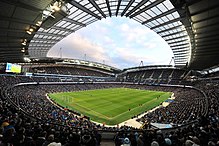
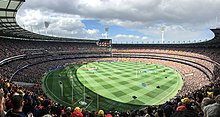

A stadium (pl.: stadiums or stadia)[1] is a place or venue for (mostly) outdoor sports, concerts, or other events and consists of a field or stage either partly or completely surrounded by a tiered structure designed to allow spectators to stand or sit and view the event.[2][3]
Pausanias noted that for about half a century the only event at the ancient Greek Olympic festival was the race that comprised one length of the stadion at Olympia, where the word "stadium" originated.[4]
Most of the stadiums with a capacity of at least 10,000 are used for association football. Other popular stadium sports include gridiron football, baseball, cricket, the various codes of rugby, field lacrosse, bandy, and bullfighting. Many large sports venues are also used for concerts.
Etymology

"Stadium" is the Latin form of the Greek word "stadion" (στάδιον), a measure of length equalling the length of 600 human feet.[5] As feet are of variable length the exact length of a stadion depends on the exact length adopted for 1 foot at a given place and time. Although in modern terms 1 stadion = 600 ft (180 m), in a given historical context it may actually signify a length up to 15% larger or smaller.[4]
The equivalent Roman measure, the stadium, had a similar length – about 185 m (607 ft) – but instead of being defined in feet was defined using the Roman standard passus to be a distance of 125 passūs (double-paces).
The English use of stadium comes from the tiered infrastructure surrounding a Roman track of such length.
Most dictionaries provide for both stadiums and stadia as valid English plurals.
History

The oldest known stadium is the Stadium at Olympia in Greece, where the ancient Olympic Games were held from 776 BC. Initially the Games consisted of a single event, a sprint along the length of the stadium.
Greek and Roman stadiums have been found in numerous ancient cities, perhaps the most famous being the Stadium of Domitian, in Rome.
The excavated and refurbished ancient Panathenaic Stadium hosted attempted revivals of the Olympic Games in 1870[6] and 1875 before hosting the first modern Olympics in 1896, the 1906 Intercalated Games, and some events of the 2004 Summer Olympics. The excavation and refurbishment of the stadium was part of the legacy of the Greek national benefactor Evangelos Zappas, and it was the first ancient stadium to be used in modern times.
Antiquity

Stadiums in ancient Greece and Rome were built for different purposes, and at first only the Greeks built structures called "stadium"; Romans built structures called "
Examples
| Name | Country | Earliest date | Track length | Track width |
|---|---|---|---|---|
| Stadium at Olympia | Greece | 776 BC | 212.54 m (697.3 ft) | 28.5 m (94 ft) |
| Stadium at Delphi | Greece | 500 BC | 177 m (581 ft) | 25.5 m (84 ft) |
| Stadium of Domitian | Italy | 80 AD | 200 m (660 ft)-250 m (820 ft) (estimated) | |
| Stadium of Philippopolis | Bulgaria | 2nd century AD (117–138 AD) | 250 m (820 ft)[9] | 32 m (105 ft) |
| Stadium at Aphrodisias | Turkey | 1st century B.C. | 225 m (738 ft) (approx.) | 30 m (98 ft) (approx.) |
Modernity


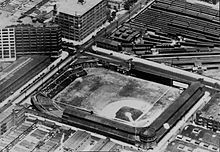


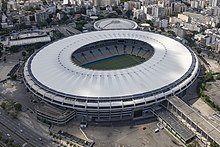
The first stadiums to be built in the modern era were basic facilities, designed for the single purpose of fitting as many spectators in as possible. With tremendous growth in the popularity of organised sport in the late Victorian era, especially association football in the United Kingdom and baseball in the United States, the first such structures were built.[10] One such early stadium was the Lansdowne Road Stadium, the brainchild of Henry Dunlop, who organised the first All Ireland Athletics Championships. Banned from locating sporting events at Trinity College, Dunlop built the stadium in 1872. "I laid down a cinder running path of a quarter-mile, laid down the present Lansdowne Tennis Club ground with my own theodolite, started a Lansdowne archery club, a Lansdowne cricket club, and last, but not least, the Lansdowne Rugby Football Club – colours red, black and yellow." Some 300 cartloads of soil from a trench beneath the railway were used to raise the ground, allowing Dunlop to use his engineering expertise to create a pitch envied around Ireland.
Other early stadiums from this period in the UK include the Stamford Bridge stadium (opened in 1877 for the London Athletic Club) and Anfield stadium (1884 as a venue for Everton F.C.).
In the U.S., many professional baseball teams built
The architect Archibald Leitch brought his experience with the construction of industrial buildings to bear on the design of functional stadiums up and down the country. His work encompassed the first 40 years of the 20th century. One of his most notable designs was Old Trafford in Manchester. The ground was originally designed with a capacity of 100,000 spectators and featured seating in the south stand under cover, while the remaining three stands were left as terraces and uncovered.[14] It was the first stadium to feature continuous seating along the contours of the stadium.[10]
These early venues, originally designed to host football matches, were adopted for use by the Olympic Games, the first one being held in 1896 in
During these decades, parallel stadium developments were taking place in the U.S. The




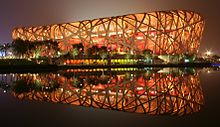
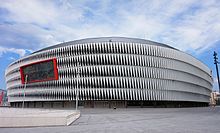




Types
Even though enclosed, dome stadiums are called stadiums because they are large enough for, and designed for, what are generally considered to be outdoor sports such as athletics, American football, association football, rugby, and baseball. Those designed for what are usually indoor sports like basketball, ice hockey and volleyball are generally called arenas. Exceptions include:
- Cameron Indoor Stadium, home to Duke University's Blue Devils men's and women's basketball programs.
- Red Bull Arena, an open-air venue that is home to Major League Soccer's New York Red Bulls and NJ/NY Gotham FC of the National Women's Soccer League.
- Paris La Défense Arena, a domed stadium that is home to the rugby union club Racing 92. It has a movable seating block that allows a configuration appropriate for indoor court sports.
- Chicago Stadium (demolished), former home to the National Hockey League's Chicago Blackhawks and the National Basketball Association's Chicago Bulls.
Design issues
Different sports require different playing surfaces of various size and shape. Some stadiums are designed primarily for a single sport while others can accommodate different events, particularly ones with retractable seating. Stadiums built specifically for association football are common in Europe; Gaelic games stadiums, such as Croke Park, are common in Ireland, while stadiums built specifically for baseball or American football are common in the United States. The most common multiple use design combines a football pitch with a running track, although certain compromises must be made. The major drawback is that the stands are necessarily set back a good distance from the pitch, especially at the ends of the pitch. In the case of some smaller stadiums, there are not stands at the ends. When there are stands all the way around, the stadium takes on an oval shape. When one end is open, the stadium has a horseshoe shape. All three configurations (open, oval and horseshoe) are common, especially in the case of American college football stadiums. Rectangular stadiums are more common in Europe, especially for football where many stadiums have four often distinct and very different stands on the four sides of the stadium. These are often all of different sizes and designs and have been erected at different periods in the stadium's history. The vastly differing character of European football stadiums has led to the growing hobby of ground hopping where spectators make a journey to visit the stadium for itself rather than for the event held there. In recent years the trend of building completely new oval stadiums in Europe has led to traditionalists criticising the designs as bland and lacking in the character of the old stadiums they replace.
In North America, where baseball and American football are the two most popular outdoor spectator sports, a number of football/baseball multi-use stadiums were built, especially during the 1960s, and some of them were successful.
Since the requirements for baseball and football are significantly different, the trend has been toward the construction of single-purpose stadiums, beginning with Kansas City in 1972–1973 and accelerating in the 1990s. In several cases, an American football stadium has been constructed adjacent to a baseball park, to allow for the sharing of mutual parking lots and other amenities. With the rise of MLS, the construction of soccer-specific stadiums has also increased since the late 1990s to better fit the needs of that sport. In many cases, earlier baseball stadiums were constructed to fit into a particular land area or city block. This resulted in asymmetrical dimensions for many baseball fields. Yankee Stadium, for example, was built on a triangular city block in The Bronx, New York City. This resulted in a large left field dimension but a small right field dimension.
Before more modern football stadiums were built in the United States, many baseball parks, including Fenway Park, the Polo Grounds, Wrigley Field, Comiskey Park, Tiger Stadium, Griffith Stadium, Milwaukee County Stadium, Shibe Park, Forbes Field, Yankee Stadium, and Sportsman's Park were used by the National Football League or the American Football League. (To a certain extent, this continues in lower football leagues as well, with the venue now known as Charles Schwab Field Omaha being used as the home stadium of the United Football League's Omaha Nighthawks.) Along with today's single use stadiums is the trend for retro-style ballparks closer to downtown areas. Oriole Park at Camden Yards was the first such ballpark for Major League Baseball to be built, using early-20th-century styling with 21st-century amenities.
There is a solar-powered stadium in Taiwan that produces as much energy as it needs to function.[20]
Stadium designers often study acoustics to increase noise caused by fans' voices, aiming to create a lively atmosphere.[21]
Lighting
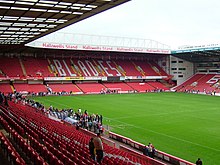
Until the advent of
Since the development of electrical grids, lighting has been an important element in stadium design, allowing games to be played after sundown, and in covered, or partly covered stadiums that allow less natural light, but provide more shelter for the public.
Spectator areas and seating

An "all-seater" stadium has seats for all spectators. Other stadiums are designed so that all or some spectators stand to view the event. The term "all-seater" is not common in the U.S., as very few American stadiums have sizeable standing-only sections. Poor stadium design has contributed to disasters, such as the Hillsborough disaster and the Heysel Stadium disaster. Since these, all Premier League, UEFA European Championship and FIFA World Cup qualifying matches require all spectators to be seated.
Seating areas may be known as terraces, tiers, or decks. Originally set out for standing room only, they are now usually equipped with seating. Another term used in the US is bleachers, which is mostly used for seating areas with bench seats as opposed to individual seats, and which often are uncovered; the name refers to the bleaching effect direct, unshaded sunlight has on the benches and patrons in those sections.
Many stadiums make luxury suites or boxes available to patrons at high prices. These suites can accommodate ten to thirty people, depending on the venue. Luxury suites at events such as the Super Bowl can cost hundreds of thousands of dollars.
Safety and security
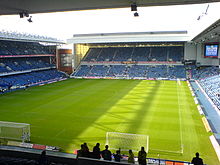

Due to the number of people congregating in stadiums and the frequency of events, many notable accidents have occurred in the past, some causing injury and death. For example, the
Much effort has been spent to avoid the recurrence of such events, both in design and legislation. Especially where there is a perceived risk of terrorism or violence attention remains high to prevent human death and keep stadiums as places where families can enjoy a public event together.
In Europe and South America, during the twentieth century, it was common for violent bands of supporters to fight inside or close to association football stadiums. In the United Kingdom they are known as hooligans.
Structural features that increase safety include separate entry and exit accesses for each spectator area, especially separating accesses for home and visitor supporters, dividing walls, glass parapets, vibration attenuation and sprinkler systems.
Security features that have been adopted include armed surveillance,
Political and economic issues

Modern stadiums, especially the largest among them, are
Corporate naming



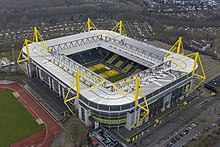


In recent decades, to help take the burden of the massive expense of building and maintaining a stadium, many American and European sports teams have sold the rights to the name of the facility. This trend, which began in the 1970s, but accelerated greatly in the 1990s, has led to sponsors' names being affixed to both established stadiums and new ones. In some cases, the corporate name replaces (with varying degrees of success) the name by which the venue has been known for many years. But many of the more recently built stadiums, like the Volkswagen Arena in Wolfsburg, Germany, have never been known by a non-corporate name. The sponsorship phenomenon has since spread worldwide. There remain a few municipally owned stadiums, which are often known by a name that is significant to their area (for example, Boston's Fenway Park). In recent years, some government-owned stadiums have also been subject to naming-rights agreements, with some or all of the revenue often going to the team(s) that play there.
One consequence of corporate naming has been an increase in stadium name changes, when the namesake corporation changes its name, or if it is the naming agreement simply expires. Phoenix's
On the other hand, Los Angeles'
in Germany have been corporately named.This new trend in corporate naming (or renaming) is distinguishable from names of some older venues, such as Crosley Field, Wrigley Field, and the first and second Busch Stadiums, in that the parks were named by and for the club's owner, which also happened to be the name of the company owned by those clubowners. (The current Busch Stadium received its name via a modern naming rights agreement.)
During the
Environmental issues
Modern stadiums bring several negative environmental issues with their construction. They require thousands of tons of materials to build, they greatly increase traffic in the area around the stadium, as well as maintaining the stadium.[23] The increased traffic around modern stadiums has led to create exposure zones says the Health Effect Institute, exposing 30–40% of people living around the stadium to potential health issues.[24] Many stadiums are attempting to counteract these issues by implementing solar panels, and high efficiency lighting, to reduce their own carbon footprint.[citation needed]
Music venues
Although concerts, such as classical music, had been presented in them for decades, beginning in the 1960s stadiums began to be used as live venues for popular music, giving rise to the term "
See also
- Architectural structure
- List of nonbuilding structure types
- Amphitheatre
- Jumbotron
- Performing arts center
- Sport venue
- Sports complex
- Theater
- List of indoor arenas
- List of sports attendance figures
- Lists of stadiums
References
- ^ Stadia is the Latin plural form, but both are used in English. Dictionary.com
- ^ Nussli Group "Stadium Construction Projects"
- ^ "The Spatial Development of the Modern Stadium". SAGE Journals.
- ^ ISBN 9780470777756.
- ^ Στάδιον, Henry George Liddell, Robert Scott, A Greek-English Lexicon, on Perseus
- ^ The Modern Olympic Games, A Struggle for Revival by David C. Young, Chapters 4 & 13
- ^ Cameron, Alan (1976). Circus Factions: Blues and Greens at Rome and Byzantium. Oxford University Press.
- ^ Beare, W. (1950). The Roman Stage: A Short History of Latin Drama in the Time of the Republic. Methuen.
- ^ [1] Ancient Stadium of Philippopolis
- ^ a b c "World Stadiums – Architecture :: Stadium history". www.worldstadiums.com. Retrieved 31 December 2019.
- ^ ISBN 978-1-4050-3431-9.
- ^ "The Move to Goodison". Everton Collection. Retrieved 5 April 2010.
- ^ "History of Goodison Park". ToffeeWeb. Retrieved 3 April 2010.
- ISBN 0-00-218426-5.
- ^ White, Valerie (1980). Wimpey: The first hundred years. George Wimpey. p. 5.
- ^ Zarnowski, C. Frank (Summer 1992). "A Look at Olympic Costs" (PDF). Citius, Altius, Fortius. 1 (1): 16–32. Archived from the original (PDF) on 28 May 2008. Retrieved 24 March 2007.
- ISBN 9781908843159.
- ^ "Dome", Merriam-Webster
- ^ Parry, Haydn (February 2013). "Super Bowl XLVII: New Orleans' pride restored after Katrina". BBC. Retrieved 15 February 2015.
- ^ Inhabitat (20 May 2009). "Taiwan's solar stadium 100% powered by the sun". The Guardian. Retrieved 2 September 2017.
- ^ Vennard, Martin (13 April 2013). "How do you give stadiums atmosphere?". BBC News. Retrieved 2 September 2017.
- ^ Lambert, Craig. "The Dow of Professional Sports" Harvard Magazine
- ^ "Big Sports Events Have Big Environmental Footprints. Could Social Licenses to Operate Help?". Forbes.
- ^ J., Grant Jr., Thomas (9 August 2018). "Green Monsters: Examining the Environmental Impact of Sports Stadiums". Villanova Environmental Law Journal. 25 (1).
{{cite journal}}: CS1 maint: multiple names: authors list (link) - ISBN 0-520-25310-8, pp. 21–31.
- ^ R. Shuker, Popular Music: the Key Concepts (London: Routledge, 2nd edn., 2002), 0415284252, p. 158.
- ^ "Arena rock". AllMusic. Archived from the original on 8 August 2013. Retrieved 20 January 2011.
- ISBN 0-8264-6321-5, p. 423.
- ISBN 1-84353-105-4, p. 835.
- ISBN 0-07-352657-6, p. 261.
- ^ "Hair metal", AllMusic. Retrieved 6 July 2010.
- ISBN 978-1-61774-463-1. Retrieved 12 February 2015.
- ISBN 978-0-87930-893-3. Retrieved 12 February 2015.
- ^ Izundu, Chi (9 September 2012). "Lady Gaga's Born This Way Ball Tour starts in the UK". BBC. Retrieved 10 February 2015.
- ^ "Taylor Swift". Gillette Stadium. Retrieved 10 February 2015.
Bibliography
- John, Geraint; Rod Sheard; Ben Vickery (2007). Stadia: A Design and Development Guide (4th ed.). Amsterdam: Elsevier/Architectural Press. ISBN 978-0-7506-6844-6.
- Lisle, Benjamin D. (2017). Modern Coliseum: Stadiums and American Culture. Philadelphia: U of Pennsylvania Press. p. 321.
- Serby, Myron W. (1930). The Stadium; A Treatise on the Design of Stadiums and Their Equipment. New York, Cleveland: American Institute of Steel, inc. OCLC 23706869.
